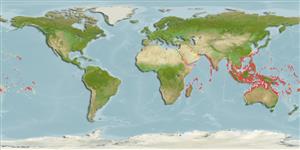分類 / Names
俗名 | 同種異名 | Catalog of Fishes(屬, 種) | ITIS | CoL | WoRMS | Cloffa
Teleostei >
Eupercaria/misc (Various families in series Eupercaria)
鱸形目 (Various families in series Eupercaria) >
Labridae (Wrasses)
隆頭魚科 (Wrasses) > Corinae
Etymology: Hemigymnus: Greek, hemi = half + Greek, gymnos = naked (Ref. 45335).
More on author: Bloch.
Environment: milieu / climate zone / 深度上下限 / distribution range
生態學
海洋 礁區魚類; 深度上下限 0 - 30 m (Ref. 9710), usually 5 - 30 m (Ref. 27115). 熱帶; 24°C - 28°C (Ref. 27115); 30°N - 36°S, 24°E - 138°W
Indo-West Pacific: Red Sea, East Africa to Samoa; north to Ryukyu Is.; south to Australia.
印度-太平洋: 紅海而且東非到密克羅尼西亞,美屬薩摩亞 (參考文獻 2334) 與玻利尼西亞.(參考文獻 9823)
大小 / 重量 / 年齡
成熟度: Lm ? range ? - ? cm
Max length : 39.6 cm TL 雄魚/尚未辨別雌雄; (Ref. 125598); 最大體重: 1.3 kg (Ref. 125598)
背棘 (總數) : 9; 背的軟條 (總數) : 10 - 11; 臀棘: 3; 臀鰭軟條: 11. This species is distinguished by the following characters: gill rakers 26-29; small juveniles dark brown, green on snout and interorbital, with a slightly oblique white bar from front of dorsal fin to abdomen, and 2 narrow pale yellowish bars below soft portion of dorsal fin that fade ventrally; larger juveniles have a white bar from origin of dorsal fin, passing beneath pectoral fin onto abdomen; head and body anterior to bar greyish green, posterior to bar black; posterior caudal peduncle and caudal fin yellow, often with 1 or 2 small black spots centrally near base: small females with body posterior to a curving demarcation between origins of dorsal and anal fins blackish with a narrow dark greenish bar on each scale, grading to yellow with blue-green spots posteriorly on caudal peduncle and fin; large females dark green posterior to oblique demarcation on body, the scales rimmed in black, with a vertical green line or spot on each scale; head and anterior body light green dorsally, pale blue-green ventrally, have irregular bands on snout and above eye, and a large complex marking behind eye; body of males posterior to demarcation dark green, each scale with narrow pale blue-green and black posterior margin; head green dorsally with irregular green to blue-green bands, including a blue ring around eye; cheek and operculum pinkish white with irregular light blue lines and spots, except for a large yellowish green blotch centrally on cheek without markings; lips and ventral part of head mainly pale blue; chest and abdomen pinkish white with a light blue spot or arc on scales (Ref. 93095).
Body shape (shape guide): fusiform / normal; Cross section: compressed.
唇隨著年齡變厚。 (參考文獻 1623) 顏色大幅改變隨著年齡與性別.(參考文獻 48636) 稚魚與亞成魚前面地幾乎白色與突然深綠色與黑色的在後部地; 在大約 8 公分下面的那些有一個慢慢地隨著成長褪色的鮮黃色的尾部。 (參考文獻 1602) 色彩鮮豔的粉紅色與藍色的臉斑紋用成長環繞稚魚的眼睛四周傳佈幾乎覆蓋大的成魚的整個頭。 (參考文獻 1602)
Found in subtidal reef flats and lagoon and seaward reefs. Juveniles occur inshore, found among branching corals while adults found in areas of mixed sand, rubble, and coral (Ref. 9710). Large adults in deeper water (Ref. 48636). Maximum length beyond 45 cm TL is unlikely, with largest measured individual at 37 cm TL (Ref, Feeds mainly on small invertebrates, especially crustaceans, polychaete worms, mollusks and brittle stars (Ref. 9823). Diet changing from primarily demersal planktonic crustaceans to hard-shelled invertebrates with growth (Ref. 37816). Minimum depth reported taken from Ref. 128797.
發現於亞潮間帶的礁石平臺與潟湖與臨海礁石了。 稚魚出現沿海地區, 發現於樹枝狀珊瑚中了雖然成魚發現於混合沙子,碎石與珊瑚的區域。 (參考文獻 9710) 大的成魚在較深的水域中。 (參考文獻 48636) 主要吃小型無脊椎動物, 尤其甲殼動物, 多毛類的蠕蟲,軟體動物與海星.(參考文獻 9823) 從主要底棲浮游性甲殼動物到具有硬殼的無脊椎動物隨著成長改變食性。 (參考文獻 37816)
Life cycle and mating behavior
成熟度 | 繁殖 | 產卵場 | 卵 | 孕卵數 | 仔魚
Oviparous, with distinct pairing during breeding (Ref. 205).印度-太平洋: 紅海而且東非到密克羅尼西亞,美屬薩摩亞 (參考文獻 2334) 與玻利尼西亞.(參考文獻 9823)
Randall, J.E., 2013. Review of the Indo-Pacific labrid fish genus Hemigymnus. J. Ocean Sci. Found. 6:2-18. (Ref. 93095)
IUCN 瀕危狀態 (Ref. 130435: Version 2025-1)
無危 (LC) ; Date assessed: 12 July 2008
人類使用
漁業: 低經濟; 游釣魚種: 是的; 水族館: 商業性
工具
特別的報告
下載 XML
網路資源
Estimates based on models
Preferred temperature (參考文獻
123201): 24.6 - 29, mean 27.8 °C (based on 1006 cells).
Phylogenetic diversity index (參考文獻
82804): PD
50 = 0.6250 [Uniqueness, from 0.5 = low to 2.0 = high].
Bayesian length-weight: a=0.01318 (0.00824 - 0.02108), b=3.06 (2.92 - 3.20), in cm total length, based on LWR estimates for this species & (Sub)family-body (Ref.
93245).
營養階層 (參考文獻
69278): 3.6 ±0.45 se; based on food items.
回復力 (參考文獻
120179): 中等的, 族群倍增時間最少 1.4 - 4.4年 (Preliminary K or Fecundity.).
Fishing Vulnerability (Ref.
59153): Low to moderate vulnerability (30 of 100).
🛈
Nutrients (Ref.
124155): Calcium = 28.8 [15.3, 87.8] mg/100g; Iron = 0.544 [0.320, 0.977] mg/100g; Protein = 18.6 [15.7, 20.8] %; Omega3 = 0.154 [0.078, 0.309] g/100g; Selenium = 31.1 [11.2, 81.1] μg/100g; VitaminA = 115 [36, 396] μg/100g; Zinc = 2.73 [0.87, 4.69] mg/100g (wet weight);
